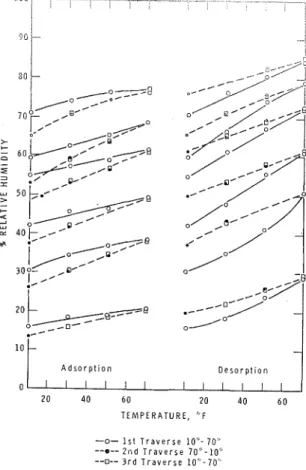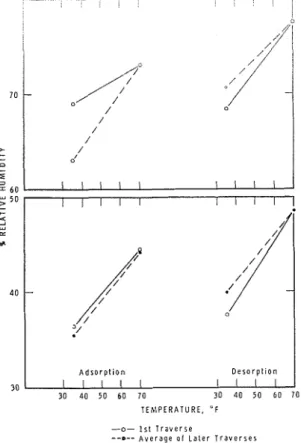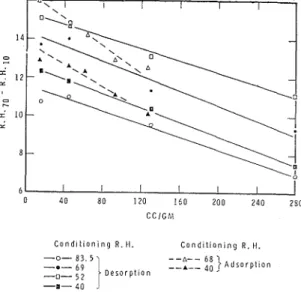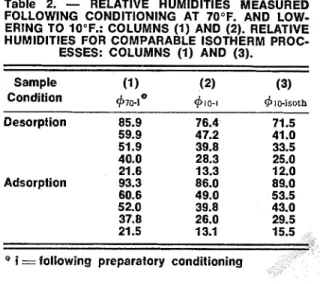Publisher’s version / Version de l'éditeur:
Wood Science, 2, 2, pp. 125-128A, 1969-10
READ THESE TERMS AND CONDITIONS CAREFULLY BEFORE USING THIS WEBSITE. https://nrc-publications.canada.ca/eng/copyright
Vous avez des questions? Nous pouvons vous aider. Pour communiquer directement avec un auteur, consultez la
première page de la revue dans laquelle son article a été publié afin de trouver ses coordonnées. Si vous n’arrivez pas à les repérer, communiquez avec nous à PublicationsArchive-ArchivesPublications@nrc-cnrc.gc.ca.
Questions? Contact the NRC Publications Archive team at
PublicationsArchive-ArchivesPublications@nrc-cnrc.gc.ca. If you wish to email the authors directly, please see the first page of the publication for their contact information.
NRC Publications Archive
Archives des publications du CNRC
This publication could be one of several versions: author’s original, accepted manuscript or the publisher’s version. / La version de cette publication peut être l’une des suivantes : la version prépublication de l’auteur, la version acceptée du manuscrit ou la version de l’éditeur.
Access and use of this website and the material on it are subject to the Terms and Conditions set forth at
Relative humidities for Douglas-fir wood between 10 and 70 F
Hedlin, C. P.
https://publications-cnrc.canada.ca/fra/droits
L’accès à ce site Web et l’utilisation de son contenu sont assujettis aux conditions présentées dans le site
LISEZ CES CONDITIONS ATTENTIVEMENT AVANT D’UTILISER CE SITE WEB.
NRC Publications Record / Notice d'Archives des publications de CNRC:
https://nrc-publications.canada.ca/eng/view/object/?id=c20c9e10-6d41-4a98-bf06-352b38478ea2 https://publications-cnrc.canada.ca/fra/voir/objet/?id=c20c9e10-6d41-4a98-bf06-352b38478ea2
Ser
TH1
NATIONAL RESEARCH COUNCIL O F CANADA
N21r 2
I no. 410
CONSEIL NATIONAL DE RECHERCHES DU CANADA
c. 2BLDG
RELATIVE HUMIDITIES FOR DOUGLAS-FIR WOOD BETWEEN
10 A N D 7 0 O ~
by
C . P. Hedlin
Reprinted from
Wood Science
Vol. 2, N o . 2, October 1969
p. 125
Research Paper No. 410
of the
Division of Building Research
I
D E C
9
1969
N A T I O N A L RESEARCH C O U N C I L
OTTAWA
October 1969
/
LES HUMLDITES RELATIVES DU BOIS DE PIN DOUGLAS E N T R E 10 E T 7 0 ° F
SO MMAIRE
L e s s p e c i m e n s de bois de pin Douglas 6taient conditionngs
>
une humidit6 f i x e'a
10, 35 et 70 O F pour d e s p h r i o d e s v a r i a n t d e 12
5s e m a i n e s . Chaque s p e c i m e n gtait e n f e r m 6 dans un contenant s c e l l e a v e c un ou p l u s i e u r s hygrom\etres g l e c t r i q u e s . L 1 6 q u i l i b r e r e l a t i f d'humiditi! d a n s l e contenant 6 t a i t m e s u r 6
'a
l a t e m p g r a t u r e initiale e t\a
une ou p l u s i e u r s a u t r e s t e m p g r a t u r e s v a r i a n t e n t r e 10 e t 70 O F . L e s humiditgs r e l a t i v e s augmentaient p r o p o r t i o n n e l l e m e n ta v e c 1'616vation d e l a t e m p g r a t u r e . Dans l e c a s d e s s p 6 c i m e n s conditionngs
'a
10 e t 35 O F , l e s v a l e u r s obtenues avec l e s p r e m i e r se s s a i s jusquf'a 70 O F n 1 6 t a i e n t p a s r 6 p 6 t 6 e s s u r l e s e s s a i s subskquents,
I
sugggrant a i n s i que l'augmentation i n i t i a l e d e la t e m p 6 r a t u r e c r 6e un changement i r r e v e r s i b l e apparent6
'a
l ' e f f e t d 1 h y s t 6 r 6 s i s . Dans l e c a s d e s s p g c i m e n s conditionn6s\a
70 O F l e s e s s a i s 6taientr g v e r s i b l e s . L e s v a l e u r s de 10 e t 70 O F pour l e s p r e m i e r s e s s a i s
6taient c o m p a r 6 e s avec l e s i s o s t z r e s c o r r e s p o n d a n t pour l e s i s o t h e r m e s p r k d g t e r min6s. L e s v a r i a t i o n s d'humiditg obtenues pour l e s p a i r e s d e s p k c i m e n s conditionngs
'a
7 0 ° F gtaient d ' u n e humidit6 r e l a t i v e diffgrente d e 4 p o u r c e n t e n v i r o n d e s v a l e u r s i s o t h e r m e s c o r r e s p o n d a n t e s , a l o r s que c e l l e s d ' u n conditionnementRelative Humidities
for
Douglas-Fir Wood
Between
10 and
70"
F.
ABSTRACT. Specimens of Douglas-fir wood were conditioned at a fixed humidity at 10, 35, and 70°F. for periods of 1 to 5 weeks. Each specimen was enclosed in a sealed container along with one or more electrical humidity sensors. The equilibrium relative humidities in the en- closures were measured at the initial temperature and at one or more temperatures in the range between 10 and 70°F.
The relative humidities increased with increasing temperature. For specimens conditioned at 10 and 35"F., tbe values obtained on the first traverse u p to 70aF. were not repeated on subsequent traverses, suggesting that the initial increase in temperature causes an irreversible change related to the hysteresis effect. For specimens conclitioned a t 70aF., the traverses were reversible.
about the sorptive process at selected temper- atures but intermediate conditions must be inferred from some assunled relationships. A
number of investigators have studied the vapor pressure-temperature relationship at fixed moist~ire content for wood.
By using oscillating conditions of tempera- ture and humidity, Stamm and Loughborough obtained moisture content-humidity curves lying behveen thc corresponding adsorption and desorption isotherms, and developed vapor pressure-temperature plots from a set of such curves (1).
Noack has described a system to measure the vapor pressure and moisture content of wood specimens at elevated temperatures. Such data could be used to test the validity of isostere extrapolations based on informa- tion obtained at lower temperatures (2).
Heats of sorption, based on calorimetric and isostere determinations, are also closely related to this question. They will not be mentioned further because they lie somewhat outside the scope of the present work, which is confined to measuring the variation of humidity with temperature for Douglas-fir in an enclosed system.
Equipment and Procedure
Douglas-fir shavings were sealed in a flask and the humidity was measured for a series of temperatures. Dunmore-type electrical humidity sensors were used and were cali- brated at the temperatures corresponding to the upper and lower limits of the traverse ( 3 ) ; humidities at intermediate levels were esti- mated by interpolation ( 4 ) .
To facilitate handling, the shavings were confined in containers made of two concen- trically mounted tubes of 40-mesh stainless steel screen. Two sizes of coiltainers were used. In the larger units, the tubes had diam- eters of 7.0 and 4.1 centimeters, and a length of 9.0 centimeters; in the smaller units they
The author is a research officer at the Prairie Regional Station (Saskatoon) of the Division of Building Re- search, National Research Council of Canacla, Ottawa. The author wishes to express his appreciation to R. G.
Nicholson, who calibrated the sensors ancl assisted with many of the tests, and to N. B. Flutcheon and G.
Litvan for their comments on the work. This paper is a contribution from the Division of Building Research, National Research Council of Canada, and is pub- lished with the approval of the Director of the Divi- sion. It was received for publication in May 1969.
Figure 1. -Shavings container (center) and glass flask with humidity sensor.
were 4.5 and 2.2 centimeters in diameter and 5.0 centimeters long. The shavings were placed in the annular space and one or more humidity sensors occupied the center cylinder. To prepare it for testing, a sample was either dried under a vacuum or moistened bv placing it over water for 1 to 4 weeks. I t was then conditioned at a humidity and tempera- ture that were fixed within about
s
0.3 per- cent relative humidity and k 0.2"F., respec- tively.Each of the larger sample containers was sealed in a stainless steel beaker by using a rubber stopper. To minimize the effect of air exchange caused by barometric pressure changes, the beaker was vented through a quantity of similarly conditioned shavings. The smaller containers were placed in flasks made by sealing the ends of the conlponents of a 55/50, ground-glass joint (Fig. 1 ) . The interior volumes of the two types were re- spectively about 450 cubic centimeters and 125 cubic centimeters. In each case, electrical humidity sensor leads were incorporated.
During conditioning the samples were weighed periodically to find the n t e of change in moisture content. The coilditioning periods ranged from 1 to 5 weeks and the rates of change at the end of conditioning ranged from 0.05 to 0.005 percent moisture content per day. The continuing changes may have been caused by small fluctuations in the tem- perature and -humidity in the conditioning apparatus or by the fact that they had not fully reached equilibrium.
After being enclosed in the
ff
ask, the systemwas allowed to eauilibrate for 12 hours or more, and the humidity was measured. For samples conditioned at 10°F., the first traverse was made by raising the temperature to 30, 50 and, finally, to 70°F. (+70., ), each step taking
o [ l l l l l l I I I I I I 20 40 6 0 20 40 6 0 TEMPERATURE. ' F -0- l s l T r a v e r s e 10"- 70" --e-- 2 n d T r a v e r s e 7 0 " - 1 0 ' --o-- 3 r d T r a v e r s e 1 0 " - 7 0 "
Figure 2.
-
Relative humidity-temperature traversesfor Douglas-fir shavings initially conditioned at 10°F.
6 to 12 hours. On the second traverse it was lowered by steps to 10°F.(+,,,), and on the third traverse, again raised by steps to 70°F. ( ~ b ~ ~ - ~ )
.
Some of the results are plotted (Fig. 2 ) . In a second set of experiments, samples of fir shavings were conditioned at 35°F. for 2% to 3 weeks. In the first run, the two sainples were conditioned at 68 percent relative humid- ity, and in the second run at 38 percent rela- tive humidity (Fig. 3 ) .In a third series of experiments, the samples were conditioned at 70°F. and traverses made down to 10°F. and back up to 70°F. (Fig. 4 ) . When determining the humidity in the flask, the measuring current was applied to the seilsor just long enough to find the sensor resistance; otherwise the heat created by con- tinuous current flow would have significantly altered the result ( 5 ) . All relative humidities at subfreezing temperatures are based on vapor pressure over supercooled water.
Results and Discussion
The process is nearly reversible when the traverse is made to temperatures below that O C T O B E R 1 9 6 9
! -0- 1 s t T r a v e r s e
- - 8 - - A v e r a g e a 1 L a l e r T r a v e r s e s
5 1
,
,
I
6 0
Figure 3.
-
Relative humidity-temperature traversesfor Douglas-fir shavings initially conditioned at 3S°F.
5 0 - ,- 5 rn * 4 0 30
of conditioning, the first such path being closely followed by succeeding ones. In the scries of tests involving conditioning at 7OoF., the average difference between the relative humidities for the first and second traverses, measured a t 30 and 50°F., was less than 0.2 percent (Fig. 4 ) .
On the other hand, when raised above the temperature of conditioning, the first traverse was not retraced on subsequent traverses over the same region (Figs. 2 and 3 ) . The second pat11 was at lower humidities than the first for adsorption, and at higher humidities than the first for desorption samples. The third traverse was substantially the same as the second, sug- gesting that the necessary conditions for re- versibility had been established. The observed shifts in relative humidity amounted to as much as 7 percent at 1O0F., but less than half as much at 35°F.
The conditions reached at 10 and 35°F. werc not stable at the higher temperatures; this suggests that an internal readjustment of moisture occurred corresponding to a decrease in hysteresis. As the moisture contents at 10°F. were below those correspoilding to vapor pressures over ice, it seems that a change of phase associated with sorbate freez-
I I I I I I i I I /e /
;/
/-
/ - / / / =/ Adsorption D e s o r p l ~ o n I l l \ ( / I l l T E M P E R A T U R E , " F 30 40 5 0 6 0 70 30 40 5 0 6 0 70 T E h l P E R A T U R E , " F -0- 1 s t T r a v e r s e-.-
2 n d T r a v e r s eFigure 4.
-
Relative humidity-temperature traversesfor Douglas-fir shavings initially conditioned at 70°F.
ing would not account for the effect ( 6 ) . This view is supported by the fact that similar changes, though of smaller magnitude, were obse~ved in samples conditioned at 35°F.
Because of the low, continually decreasing rate of moisture exchange toward the termina- tion of conditioning, it is assumed that the ina- terial was near to equilibrium. However, if it was in fact far from ecluilibriuin, the increase in temperature might simply have hastened the approach to the moisture arrangement that would have bcen reached if sufficient time had been allowed to elapse.
A further possibility is that changing the temperature resulted in temperature gradients and a redistribution of ~noisture within the sample and that it did not return to the initial relative humidity because of this change in distribution. This seems unlikely, however, as a similar process would also be expected to occur when the conditioning temperature wcls at the top of the traversed range.
Errors Due to Moisture Exchange
A moisture exchange occurs between the shavings and the space in the flaslc due to the change in temperature. At 50 percent relative W O O D S C I E N C E V o l . ~ , N o . 2
CONDITIONED A T 16% R . H . CONDITIONED A T 3 0 % R H DESORPTION ADSORPTION
-0- 1 s t T r a v e r s e (10' ta i 0 ' ) -0- 1 s t T r a v e r s e
- - 0 - - 2 n d T r a r , e r s e ( 7 0 " to 10'1 - - 8 - - 2 n d T r a v e r s e
Figure 5.
-
Differences between relative humiditiesat 70°F. and 10°F. plotted against reciprocal aver-
age sample density. Samples conditioned at 10°F.
humidity, the atmosphere in a 125 cubic centi- meter flask contains about 1 milligram of vapor at 70°F., but only 0.1 milligram at 10°F. Under these conditions, a 5-gram sample must absorb about 0.02 percent moisture by weight during the cooling and desorb it when the temperature is raised.
To test the effect on the results, several containers were prepared, differing only in the amounts of shavings in the sample. A tem- perature traverse was made followiilg condi- tioning, The relative humidities at 10 and 70°F. were measured and the difference plotted against the quantities of shavings in the samples.
Figure 5 presents the results for botli first and second traverses for material conditioned at 10°F. If the lines fitting the data are es- trapolated linearly to the ordinates, the error for the first traverse is about 0.2 percent rela- tive humidity for a volume to weight ratio of 17 cubic centimeters per gram, and would be correspondingly greater for the 48 and 85 cubic centimeters per gram cases (Table 1). Results in Figure 6 are for material con- ditioned at 70°F. The error ranges from 0.3 to 0.5 percent relative humidity for 17 cubic centimeters per gram cases; this volume to weight ratio applies to all cases in Table 2.
Comparison with Isotherm Results
Isotherm results previously determined with the fir specimens used in this work (Fig. 7) were compared with the present results by considering supposedly, equivalent processes in the two sets $"experiments. Thus, the
Figure 6.
-
Differences between relative humiditiesat 70°F. and 10°F. plotted against reciprocal aver-
age sample density. Samples conditioned at 70°F.
process of conditioning a sample at 10°F. and and raising its temperature to 70°F., is comparable, though not necessarily thermo- dynamically equivalent, to following a con- stant moisture line on an isotherm plot from the silme value + l o - i to the appropriate 70°F.
isotherm. The second comparison involves the reverse process, starting at 70°F. and going to 10°F.
The results of several of the first type of comparison are given in Table 1. In the first instance, a sample, conditioned at 71 percent relative humidity and 1O0F., reached 85.5 per- cent relative humidity ~ v h e n raised to 70°F. A constant moisture line, intersecting the 10°F. isotherm at 71 percent relative humidity, cuts the 70°F. desorption isotherm at 86 percent relative humidity (Fig. 7 ) .
E e l v i e e n t h e 10 a n d 70°F D e r o r p t i a n I r a l t i e r m s
,
/ / / l R e l a t ~ v e H u n l d ~ l y R r l e r r e d l a S u o e r c o o l e d w a t e r ) R E L A T I V E H U M I D I T Y . 5Figure 7.
-
Isotherms of Douglas-fir.The average difference, between all of the values of +,&I and +70.isoth is 1.1 percent relative
humidity. On average,
+,,I
is 1.2 percent highy than 47&isoth for desorption and 0.7 percentlower for adsorption cases. The data in Figure 5 are not adequate to apply the correction described in the preceding section, but such a correction would increase d , ~ , . thus increas- ing the differences for desorption and decreas- ing those for adsorption. It appears that this process at fixed total moisture is in approxi- mate agreement with its isotherm counterpart. Experimental errors occurring in the humidity measurement and wood sorption measure- ments may contribute to the observed differ- ences.
Table 2 gives results for material condi- tioned at 70°F.
+,,-I
and + l O - i s o ~ h differ by anaverage of 3.8 percent relative humidity, the values being less than the corresponding
+l&isoth values for adsorption and exceeding
those of desorption in all cases. Conclusions
Douglas-fir shavings, conditioned at fixed L>
humidity and temperature, were sealed in con- tainers to study temperature-humidity rela- tionships. An irreversible change appeared to
Table 1.
-
RELATIVE HUMIDITIES MEASUREDFOLLOWING C O ~ ~ D I T I O N I ~ G A T 10'~. A N D RAIS-
ING TO 70°F.: COLUMNS (1) AND (2). RELATIVE
HUMlDlTlES FOR COMPARABLE lSOTHERM PROC-
ESSES: COLUMNS (1) AND (3).
Sample cc./gm of Condition shavings Desorption 48 21 48 48 48 18 18 Adsorption 85 17 85 85 85 17.5 17.5 Desorption 17 68.5 77.7 78.0 17 37.6 48.5 45.0 Adsomtion 18 69.0 74.0 73.0
i = lollowlng preparatory conditioning
Table 2.
-
RELATIVE HUMIDITIES MEASURED -~FOLLOWING
CONDITIONING
AT 70°F. AND LOW-ERING TO 10°F.: COLUMNS (1) AND (2). RELATIVE
HUMIDITIES FOR COMPARABLE ISOTHERM BROC-
ESSES: COLUMNS (1) AND (3).
Sample (1 (2) (3)
Condition 470-iO
410-1
4 10-isothDesorption 85.9 76.4 71.5
59.9 47.2 41 .O
Adsorption 93.3 86.0 89.0
60.6 49.0 53.5 52.0 39.8 43.0
*
i = following preparatory conditioningtake place in material conditioned at 10 or 35°F. when raised to 70°F., because the initial path was not retraced on return to the lower temperatures.
The humidity ranges spanned by these traverses were compared with those of cor- responding isotherm processes and showed approximate agreement.
For samples conditioned at 70°F., the humidity-temperature path that was followed on lowering the temperature was closely re- traced when the temperature was raised.
The error caused by moisture exchange within the container varies with the density of material, and appears not to exceed 0.5 percent relative humidity for volume/weight ratios of 20 cubic centimeters per gram.
Literature Cited
1. STALIAI, A. J., AND W. K. LOUGIIBOROUGH. 1935. Thermo-dynamics of the swelling of wood. J. Phys. Chem. 39: 121-132.
2. NOACK, D. 1959. Contribution to the sorption of wood at elevated temperatures and water vapor pressures. Holz als Roh-und Werkstoff. 5:205-212. 3. HANDEGORD, G. O., AND C. E. TILL. 1960. New
humidity standard. Trans. ASHRAE 66:288-308. 4. HEDLIN, C. P. 1965. A. Resistance-humidity rela-
tionship for sensors of the Dunmore-type. Proc. International Symposium on Humidity and Mois- ture, Washington, D.C. 1963. Reinhold. 1:273-279.
5. , G. 0. HANDEGORD, AND R. G. NICH- OLSON, 1967. The electrical heating effect in Dun- more sensors. National Research Council of Can- ada. Division Building Research, Building Re- search Note No. 61, Ottawa.
6. KUBLER, H. 1962. Formation of ice crystals in moist substances. Kaltetechnik 14(10):322-325.



